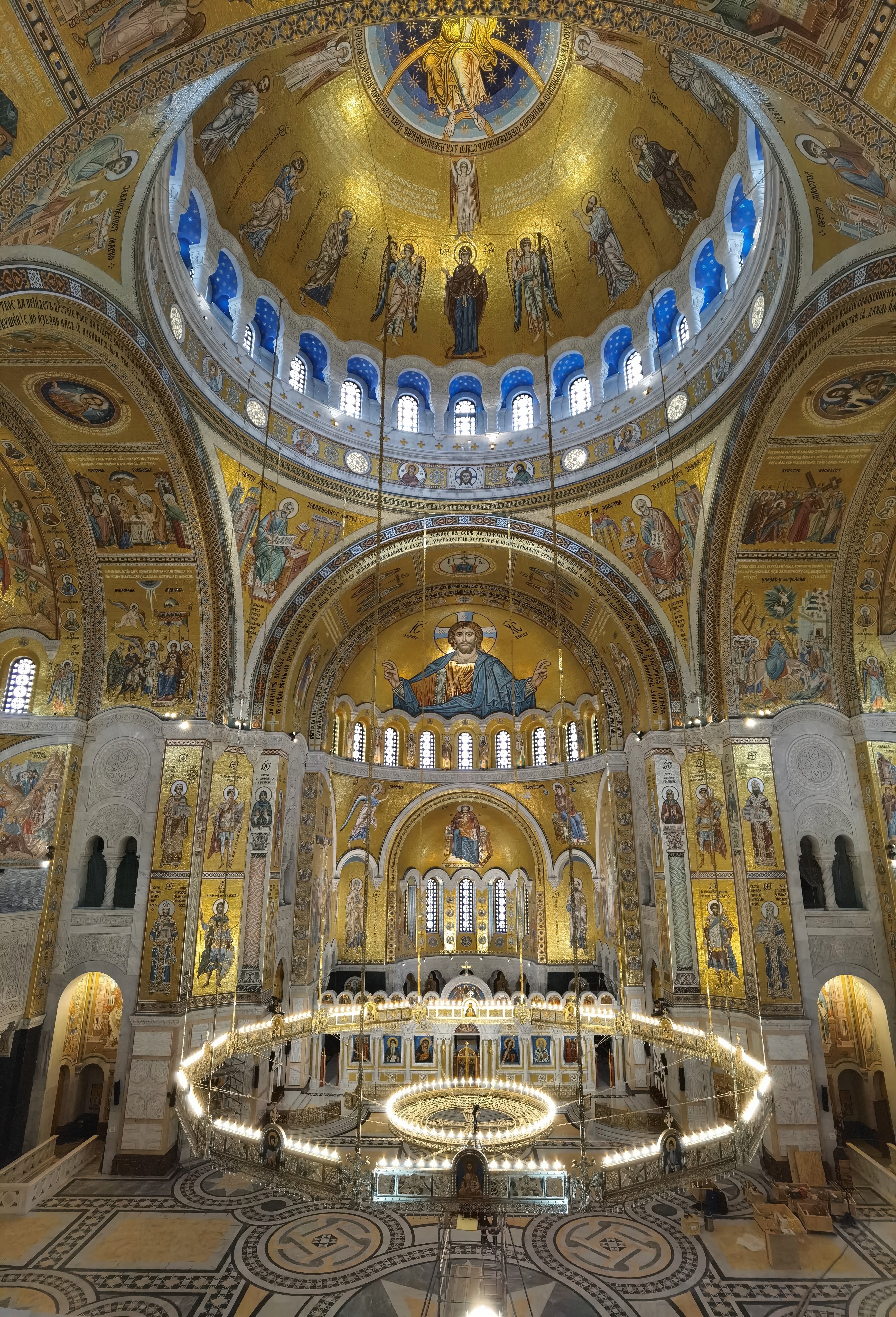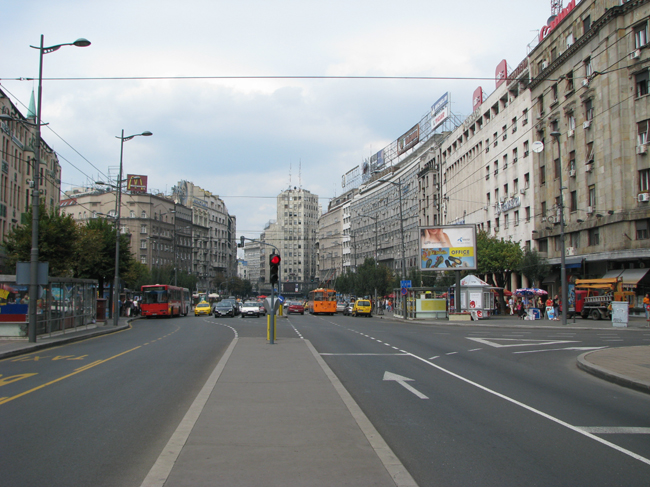|
Cathedral Of Saint Sava
The Church of Saint Sava ( sr-Cyrl, Храм Светог Саве, Hram Svetog Save, lit='The Temple of Saint Sava') is a 79 m high Serbian Orthodox church, which sits on the Vračar plateau in Belgrade, Serbia. It was planned as the bishopric seat and main cathedral of the Serbian Orthodox Church. The church is dedicated to Saint Sava, the founder of the Serbian Orthodox Church and an important figure in medieval Serbia. It is built on the presumed location of St. Sava's grave. His coffin had been moved from Mileševa Monastery to Belgrade. The coffin was placed on a pyre and burnt in 1595 by Ottoman Grand Vizier Sinan Pasha. Bogdan Nestorović and Aleksandar Deroko were finally chosen to be the architects in 1932 after a second revised competition in 1926–27 (for which no first award was granted, Nestorović being runner up). This sudden decision instigated an important debate in interwar Yugoslavia which centered around the temple's size, design and symbolic national fu ... [...More Info...] [...Related Items...] OR: [Wikipedia] [Google] [Baidu] |
Vračar
Vračar ( sr-Cyrl, Врачар, ) is an affluent urban area and Subdivisions of Belgrade, municipality of the city of Belgrade known as the location of many embassies and museums. According to the 2022 census results, the municipality has a population of 55,406 inhabitants. With an area of only , it is the smallest of all Belgrade's (and Serbian) municipalities, but also the most densely populated. Vračar is one of the three municipalities that constitute the very center area of Belgrade, together with Savski Venac and Stari Grad, Belgrade, Stari Grad. It is an affluent municipality, having one of the most expensive real estate prices within Belgrade, and has the highest proportion of university educated inhabitants compared to all other Serbian municipalities. One of the most famous landmarks in Belgrade, the Church of Saint Sava, Saint Sava Church is located in Vračar. Vračar borders five other Belgrade municipalities: Voždovac to the south, Zvezdara to the east, Palilula t ... [...More Info...] [...Related Items...] OR: [Wikipedia] [Google] [Baidu] |
List Of Largest Eastern Orthodox Church Buildings
This is a list of the largest Eastern Orthodox Church, Eastern Orthodox church buildings in the world, based on area and capacity. Any Eastern Orthodox church building that has a capacity of 3,000 people or more, can be added to this page. Entries are included even if a premises otherwise meeting the criterion currently does not function as a church. For example, the Hagia Sophia in Turkey is included – it was originally built as a church but was later converted into a mosque. Sorting is done by volume (priority) and area. The church buildings are listed in alphabetical order according to country. The churches are from various jurisdictions of the Eastern Orthodox Church. List See also *List of tallest Eastern Orthodox church buildings *List of largest church buildings *List of tallest domes *Lists of cathedrals *List of Greek Orthodox churches in the United States *List of Russian Orthodox churches Footnotes References {{DEFAULTSORT:List of Large Orthodox Cathedrals ... [...More Info...] [...Related Items...] OR: [Wikipedia] [Google] [Baidu] |
Terazije
Terazije ( sr-Cyrl, Теразијe) is the central town square and the surrounding neighborhood of Belgrade, Serbia. It is located in the municipality of Stari Grad, Belgrade, Stari Grad. Today, Terazije has primarily function of the main transit square, surrounded by the important public buildings, cultural institutions, hotels, public monuments and parks. Though not classically shaped square, Terazije was historically important as the gathering spot and the former business and commercial center of Belgrade. With the Knez Mihailova Street, which extends to the northeast connecting directly Terazije and Belgrade Fortress, the square is one of the oldest and most recognizable ambience units of Belgrade. Due to its historical and cultural importance, Terazije was declared a protected spatial cultural-historical unit in January 2020. Location Despite the fact that many Belgraders consider the Republic Square (Belgrade), Republic Square or Kalemegdan to be the city's centerpiece ... [...More Info...] [...Related Items...] OR: [Wikipedia] [Google] [Baidu] |
First Serbian Uprising
The First Serbian Uprising (; sr-Cyrl, Први српски устанак; ) was an uprising of Serbs in Orašac (Aranđelovac), Orašac against the Ottoman Empire from 14 February 1804 to 7 October 1813. The uprising began as a local revolt against the Dahije, renegade janissary officers who had seized power in a coup d'état against the Ottoman sultan. It later evolved into a Wars of national liberation, war for independence, known as the Serbian Revolution, after more than three centuries of Ottoman Empire rule and brief Austrian occupations. In 1801, the Janissary commanders assassinated the Ottoman Empire, Ottoman Pasha and took control of the Pashalik of Belgrade, ruling it independently of the Ottoman Sultan. This led to a period of tyranny, during which the Janissaries suspended the rights previously granted to the Serbs by the Sultan. They also raised taxes, imposed forced labor, forced labour, and made other changes that negatively affected the Serbs. In 1804, the Ja ... [...More Info...] [...Related Items...] OR: [Wikipedia] [Google] [Baidu] |
Burning Of Saint Sava's Relics
When the Serbs in Banat rose up against the Ottomans in 1594, using the portrait of Saint Sava on their war flags, the Ottomans retaliated by incinerating the relics of St. Sava on the Vračar plateau in Belgrade. Grand Vizier Sinan Pasha, the main commander of the Ottoman army, ordered that the relics be brought from Mileševa to Belgrade, where he had them burned on 27 April. Monk Nićifor of the Fenek monastery wrote that "there was great violence carried out against the clergy and devastation of monasteries". The Ottomans sought to symbolically and really incinerate the Serb determination to be free, a determination which had been growing noticeably. Instead, the burning sparked an increase in rebel activity, until the suppression of the uprising in 1595. It is believed that his left hand was saved; it is currently held at Mileševa. Commemoration Commemoration of the burning of Saint Sava's relics () is now a Serbian Orthodox religious holiday celebrated on 27 April (1 ... [...More Info...] [...Related Items...] OR: [Wikipedia] [Google] [Baidu] |
Protected Spatial Cultural-Historical Units (Serbia)
Protected Spatial Cultural-Historical Units (/) are the monuments in the Republic of Serbia that have the third level of the State protection. Those are part of the Cultural Property of Great Importance protection list. References Further reading ''Просторне културно-историjске целине''at www.spomenicikulture.mi.sanu.ac.rs See also * Cultural Property of Great Importance * Serbian culture Serbian culture is a term that encompasses the Serbian art, artistic, Serbian cuisine, culinary, Serbian literature, literary, Music of Serbia, musical, Politics of Serbia, political and Serb traditions, social elements that are representati ... {{Culture of Europe Culture of Serbia Monuments and memorials in Serbia Cultural heritage of Serbia ... [...More Info...] [...Related Items...] OR: [Wikipedia] [Google] [Baidu] |
Aleksandar Vučić
Aleksandar Vučić, (born 5 March 1970) is a Serbian politician serving as President of Serbia since 2017. A founding member of the Serbian Progressive Party (SNS), he previously served as President of the SNS from 2012 to 2023, Deputy Prime Minister of Serbia, First Deputy Prime Minister from 2012 to 2014, and Prime Minister of Serbia from 2014 to 2017. Born in Belgrade, Vučić graduated as a lawyer from the University of Belgrade Faculty of Law, Faculty of Law of University of Belgrade. Vučić began his political career in 1993, as a member of the Far-right politics in Serbia, far-right Serbian Radical Party (SRS) in the National Assembly of Serbia. In 1995, he became the secretary-general of SRS. He was appointed Ministry of Information and Telecommunications (Serbia), minister of information in 1998 in the government of Mirko Marjanović. During his tenure as minister, which lasted until the overthrow of Slobodan Milošević in 2000, Vučić introduced restrictive meas ... [...More Info...] [...Related Items...] OR: [Wikipedia] [Google] [Baidu] |
Irinej, Serbian Patriarch
Irinej ( sr-Cyrl, Иринеј, , ; born Miroslav Gavrilović; 28 August 193020 November 2020) was the head of the Serbian Orthodox Church from 2010 until his death in 2020. He had first been the bishop of Niš between 1975 and 2010, and then the patriarch of the Serbian Orthodox Church from 22 January 2010 succeeding Pavle, until his death. He was considered, both abroad and at home, to be a moderate traditionalist, open to global inter-religious dialogue. Early life Irinej was born as Miroslav Gavrilović (; sr-Cyrl, Мирослав Гавриловић) in Vidova near Čačak, Kingdom of Yugoslavia (now Serbia). After graduating from high school, he enrolled and completed the Serbian Orthodox Seminary of Prizren. He then enrolled at the University of Belgrade's Theological Faculty and served in the army after graduating. After compulsory military service, he was tonsured a monk in 1959 in Rakovica monastery, receiving the monastic name of "Irinej" (from , ; Irenaeus). ... [...More Info...] [...Related Items...] OR: [Wikipedia] [Google] [Baidu] |
COVID-19 Pandemic
The COVID-19 pandemic (also known as the coronavirus pandemic and COVID pandemic), caused by severe acute respiratory syndrome coronavirus 2 (SARS-CoV-2), began with an disease outbreak, outbreak of COVID-19 in Wuhan, China, in December 2019. Soon after, it spread to other areas of Asia, and COVID-19 pandemic by country and territory, then worldwide in early 2020. The World Health Organization (WHO) declared the outbreak a public health emergency of international concern (PHEIC) on 30 January 2020, and assessed the outbreak as having become a pandemic on 11 March. COVID-19 symptoms range from asymptomatic to deadly, but most commonly include fever, sore throat, nocturnal cough, and fatigue. Transmission of COVID-19, Transmission of the virus is often airborne transmission, through airborne particles. Mutations have variants of SARS-CoV-2, produced many strains (variants) with varying degrees of infectivity and virulence. COVID-19 vaccines were developed rapidly and deplo ... [...More Info...] [...Related Items...] OR: [Wikipedia] [Google] [Baidu] |
TASS
The Russian News Agency TASS, or simply TASS, is a Russian state-owned news agency founded in 1904. It is the largest Russian news agency and one of the largest news agencies worldwide. TASS is registered as a Federal State Unitary Enterprise, owned by the government of Russia. Headquartered in Moscow, it has 70 offices in Russia and in the Commonwealth of Independent States (CIS), "along with 56 global branches in 53 countries". In the Soviet period, it was named the Telegraph Agency of the Soviet Union () and was the central agency of the Soviet government for news collection and distribution for all Soviet newspapers, radio and television stations. After the dissolution of the Soviet Union, it was renamed Information Telegraph Agency of Russia (ITAR-TASS) () in 1992, but reverted to the simpler TASS name in 2014. Currently, on a daily basis TASS is "publishing nearly 3,000 news items in six languages and about 700 photographs and videos from correspondents in Russia and a ... [...More Info...] [...Related Items...] OR: [Wikipedia] [Google] [Baidu] |
RIA Novosti
RIA Novosti (), sometimes referred to as RIAN () or RIA (), is a Russian state-owned domestic news agency. On 9 December 2013, by a decree of Vladimir Putin, it was liquidated and its assets and workforce were transferred to the newly created Rossiya Segodnya agency. On 8 April 2014, RIA Novosti was registered as part of the new agency. RIA Novosti is headquartered in Moscow. The chief editor is Anna Gavrilova. Content RIA Novosti was scheduled to be closed down in 2014; starting in March 2014, staff were informed that they had the option of transferring their contracts to Rossiya Segodnya or sign a redundancy contract. On 10 November 2014, Rossiya Segodnya launched the Sputnik multimedia platform as the international replacement of RIA Novosti and Voice of Russia. Within Russia itself, however, Rossiya Segodnya continues to operate its Russian language news service under the name RIA Novosti with itria.ruwebsite. The agency published news and analyses of social-politic ... [...More Info...] [...Related Items...] OR: [Wikipedia] [Google] [Baidu] |



